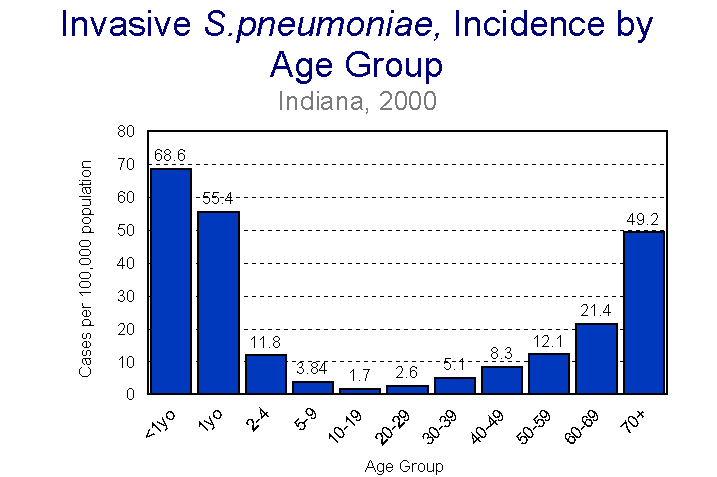Figure Strep1. Invasive S. pneumoniae Incidence, Indiana, 2000

2000 Indiana Report of Infectious Diseases |
View ISDH's Quick Facts on Pneumococcal infections
View CDC's Streptococcus pneumoniae infection page
Rates presented are per 100,000 population and are based on the U.S. 2000 Census.
Cases = 710
Crude Case Rate = 11.68/100,000 population
Surveillance of invasive Streptococcus pneumoniae (pneumococcal disease) has been ongoing in Indiana since June 1998. Among all Indiana residents, 710 cases were reported (11.68/100,000 population) in 2000, compared with 691 cases (11.63) in 1999. Incidence of invasive pneumococcal disease varies considerably with age, with the highest rates occurring in children ages 2 or less and ages 65 and older (Figure Strep1).
Isolates were obtained from nine different sterile sites; blood was the most frequent site reported with 652 cases (87.5%). Thirty-five of the individual cases were reported as having S. pneumoniae isolated from two different sites, and one case had isolates from three different sites, making a total of 746 different isolates obtained from the 710 cases. Figure Strep2 shows the percentage of isolates from each site. Sterile sites with less than three isolates reported were classified as other.
Of the 592 reported cases where race was identified, whites accounted for 471 (79.2%) and blacks accounted for 122 (20.6%). Race was unknown for 118 of the reported cases.
Among the 710 cases total reported cases, 93 resulted in death. The outcome of 109 cases was not reported, therefore a death rate of 15.5% (93/601) was recorded for all ages, when outcome was known. Five deaths occurred in infants ages less than 1. The death rate for infants ages 0-11 months, with known outcome, was 10.4% (5/48).
Antibiotic resistance has become an emerging world, national, and state problem in the treatment of Streptococcus pneumoniae invasive disease. In the U.S., DRSP has increased substantially in the past 15 years; DRSP varies regionally and has been reported to be over 30% in some areas of the U.S.
In Indiana during 2000, drug sensitivity profiles were received on 632 (92.5%) isolates. Of the cases where sensitivity information was available, 31.7% had either high level (17.1%) or intermediate level (14.6%) resistance to penicillin. The percent of penicillin-resistant isolates among cases ages less than six is even higher at 43% (17.2% intermediate resistance and 25.8% high level resistance). When considering resistance of cerebrospinal fluid (CSF) isolates in infants ages 0-2, 9 of the 17 (52.9%) isolates were resistant to penicillin (35.3% high level and 17.6% intermediate level). To better understand the resistance rates in Indiana, Table Strep1 lists the number of isolates and their sensitivity by county. To compare data from 1999 to this table see Appendix D of the 1999 Indiana Report of Diseases of Public Health Interest. If you do not have a copy of this report, you can access it at the Indiana State Department of Health web site at:
www.IN.gov/isdh/dataandstats/disease/1999/index.htm
Sensitivity data can be compared from year-to-year to determine if the organism is becoming more resistant to various antibiotics. Table Strep2 shows selected antibiotics and the rate of resistance reported in 1999 and 2000. As can be seen, the percent of isolates that were resistant increased for each antibiotic listed, with the exception of vancomycin which remained at 0%.
Completeness and accuracy of data are critical to maintaining a functional surveillance system. Table Strep3 depicts the state rates for completeness of data based on cases reported in 1999 and 2000. This table shows some improvement was made from 1999 to 2000 in the collection of age, drug sensitivity, and vaccine history data. Improvement is still needed in collecting race data and vaccine histories.
Vaccine history information has become more critical with the introduction of the seven valent pneumococcal conjugate vaccine. In 2001, the Indiana State Department of Health Laboratory, in cooperation with selected hospital and private laboratories, will begin serotyping isolates from children ages less than 6. From this information the ISDH will be able to compare vaccine history with the serotype of the case to determine if vaccine failures are occurring.
Back to Top of Article
Back to Table of Contents
|
Figure Strep1. Invasive S. pneumoniae Incidence, Indiana, 2000 |
|
|
Back to Reference in Text
Back to Top of Article
|
Figure Strep2. Invasive S. pneumoniae Isolates, Specimen Source, Indiana, 2000 |
|
|
Back to Reference in Text
Back to Top of Article
Back to Reference in Text
Back to Top of Article
|
Table Strep2. Invasive S. pneumoniae, Antimicrobial Resistance Rate of Selected Antibiotics, Indiana, 1999-2000 |
|||||||||||||||||||||||||||||||||||||||||||||||||
|
|||||||||||||||||||||||||||||||||||||||||||||||||
Back to Reference in Text
Back to Top of Article
|
Table Strep3. Invasive S. pneumoniae, Completeness of Data for Reported Cases, Indiana, 1999-2000 |
|||||||||||||||||||
|
|||||||||||||||||||
Back to Reference in Text
Back to Top of Article
[an error occurred while processing this directive]